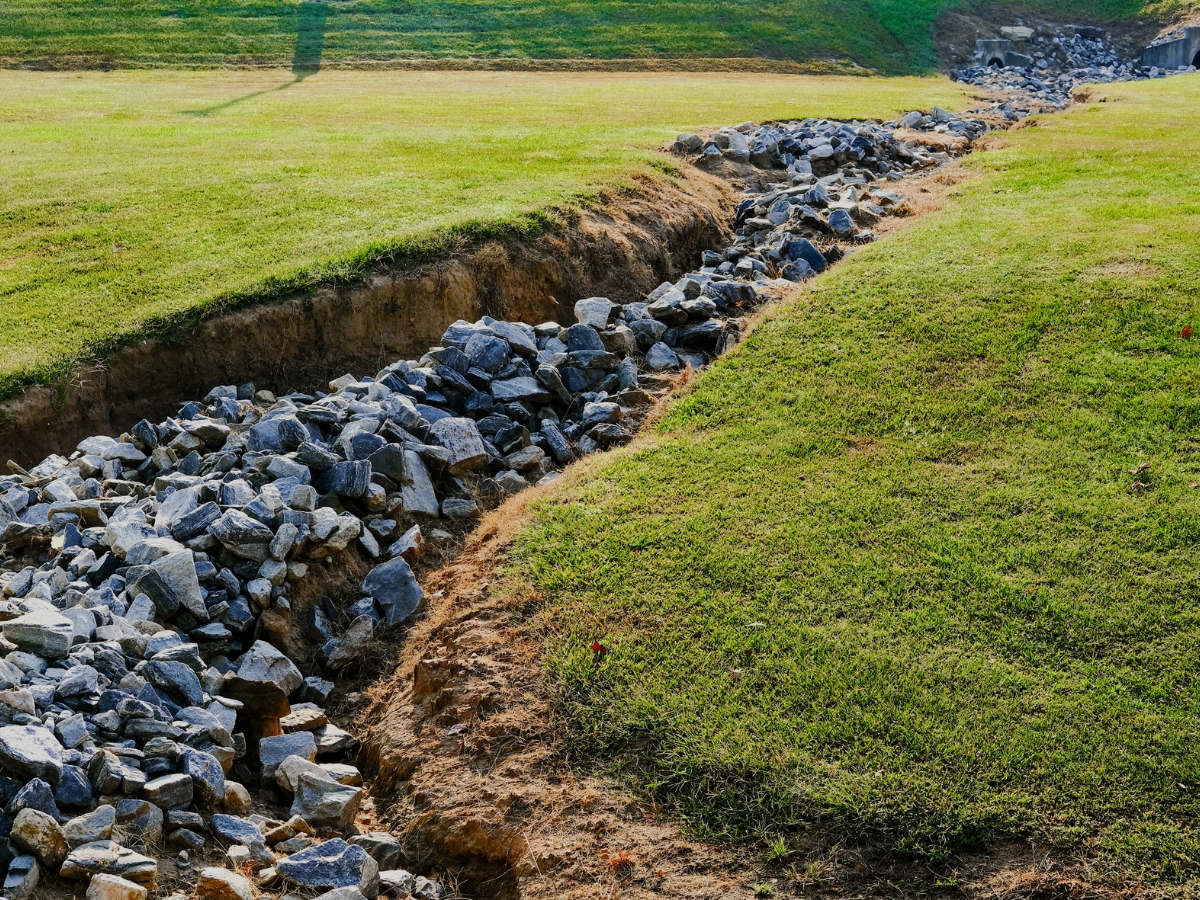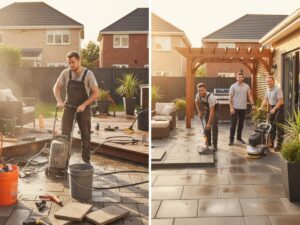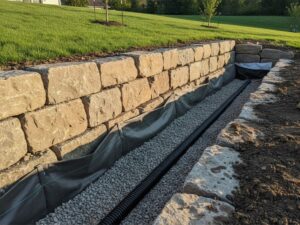Poor yard drainage is one of the most common problems homeowners face, and if it’s not addressed quickly, it can cause serious damage like waterlogged lawns, dying plants, to soil erosion. Fortunately, there are modern and feasible yard drainage solutions offered by experienced yard drainage contractors designed to redirect or absorb excess water, keeping your landscape dry and your home safe.
In this blog, we’ll explore these feasible drainage solutions, how they work, and why investing in the right system is the key to protecting your landscape and preventing costly water damage.
Common Yard Drainage Challenges Homeowners Face
Improper Yard Slope or Pitch
One of the leading causes of drainage issues is an inadequate slope or pitch in the yard. If the ground isn’t angled enough to move water away from the home, rainwater tends to pool around the foundation or in low spots across the lawn. Professional water drainage solutions, such as regrading or installing French drains, can often correct these issues.
Water Trapped Near Walkways and Entrances
Flat or poorly designed walkways, particularly those running parallel to the home, often act like dams that trap water between the house and the pavement. This creates puddles that linger after rain and may even direct water toward the foundation. It’s a classic case within common yard drainage issues & fixes that often requires tailored contractor solutions.
Downspout and Gutter Problems
Instead of directing water safely away, they sometimes release it too close to the home, leading to basement leaks, damp foundations, and erosion. In some cases, gutters and downspouts overflow during heavy rain. Spilling large amounts of water directly onto the landscape and overwhelming the soil’s ability to absorb it.
Soil Erosion from Runoff
When water isn’t managed properly, it can create concentrated flows that strip away topsoil, wash out garden beds, and carve unsightly channels into the yard. This erosion damages the lawn and makes the landscape uneven, worsening drainage problems. Over time, erosion can destabilize slopes and lead to expensive landscaping repairs.
Persistent Soggy Spots
Some areas of a yard never seem to dry, no matter how long it’s been since it last rained. These soggy zones may be caused by low-lying depressions, underground springs, or compacted soil that prevents absorption. Aside from being unpleasant to walk on, these wet areas can suffocate grass and plants, turning once-healthy patches into muddy dead zones.
Foundation Risks
Perhaps the most serious consequence of poor drainage is water pooling around a home’s foundation. Persistent moisture can lead to cracks, basement leaks, mold growth, and even structural instability.
Blocked or Inefficient Drains
When existing drains become clogged with leaves, silt, or invasive tree roots, they lose their ability to carry water away from the property. Blocked drains can cause water to back up into yards, driveways, or even basements, leading to localized flooding and sanitation risks.
Feasible Drainage Solutions Offered by Contractors
Let’s discuss the most feasible yet effective yard drainage solutions: –
French Drains
What it is: A gravel-filled trench with a perforated pipe that collects subsurface water and carries it to a safe discharge point. Yard drainage contractors ensure the trench has proper slope, correct stone size, and fabric installation so the system functions long-term without clogging
Best for: Chronic soggy zones, wet lawn edges, bases of slopes, or along foundations where groundwater or seepage accumulates.
How it works: Water percolates through washed angular gravel, passes through a geotextile filter, enters the perforated pipe, and flows (by gravity) to “daylight,” a dry well, or a storm connection (where permitted).
Key Details That Matter:
- Typical trench: ~8–12 in. wide, ~18–36+ in. deep (depth driven by where the water is).
- Pipe: usually 4 in. perforated; consistent hole orientation per design; minimum continuous fall of ~1% toward the outlet.
- Materials: non-woven geotextile to keep fines out; washed angular stone (no dirt/sand).
- Access: cleanouts and an accessible outlet make maintenance possible.
Dry Wells
What it is: A buried chamber (modular plastic unit or rock-filled pit) that temporarily stores runoff and lets it infiltrate into surrounding soil.
Best for: Handling roof/downspout water on sites with decent infiltration and enough setback from structures.
How it works: Downspouts feed the chamber; water fills, then gradually soaks into the native soil. An overflow route handles extreme storms.
Key Details That Matter:
- Sizing is based on contributing roof/impervious area and design storm; yard drainage contractors commonly run a simple runoff calculation.
- Soil/percolation testing determines feasibility; high clay or high water table = poor fit.
- Setbacks: keep well away from foundations (commonly 10+ ft) and property lines; maintain separation above groundwater.
- Pretreatment: leaf screens or a small sediment sump protect the chamber from fines.
Catch Basins & Channel Drains
What they are: Surface inlets that capture sheet flow before it spreads, point inlets (catch basins with grates) and linear inlets (channel/trench drains).
Best for: Low points in lawns, bottoms of driveways, along garage thresholds and patios, or spots where walkways “dam” water.
How they work: Water drops through the grate into a sump (for basins) or runs along a slotted channel; then a solid pipe conveys it to an approved discharge. Yard drainage contractors know how to identify natural low points and connect these surface inlets to reliable outfalls. Preventing issues like standing water or erosion
Key Details That Matter:
- Placement at true low spots; ensure continuous pipe slope (≈1%+) to the outlet.
- Grate and channel sizing must match expected peak flow; traffic-rated grates for driveways.
- Maintenance plan: debris removal from grates and periodic sump cleanout.
Grading & Sloping (Regrading)
What it is: Re-shaping the site so water naturally flows away from structures and toward designated collection paths.
Best for: Yards with broad, systemic drainage issues or homes set too low relative to surrounding grade.
How it works: Professional yard drainage contractors recontour soil to create positive drainage and may introduce shallow swales to guide runoff.
Key Details That Matter:
- Near the house: commonly target ~5% fall for the first 10 ft (≈6 in. drop over 10 ft).
- Across the yard: gentle, consistent fall (≈1–3%) toward swales, basins, or outfalls.
- Protect structures: keep final grade below siding and thresholds; avoid burying weep screeds or vents.
- Integrate hardscapes: walks/driveways shouldn’t create unintended dams.
Downspout Extensions
What they are: Above-ground or buried pipes that carry roof runoff well away from the foundation.
Best for: Wet basements, damp foundations, or visible splash-back where downspouts discharge too close to the house.
How they work: Extensions (often 10–20+ ft) connect to solid PVC/HDPE pipe and discharge at daylight, a pop-up emitter, a dry well, or another approved outfall.
Key Details That Matter:
- Ensure gutters/downspouts are clean and appropriately sized so they don’t overflow.
- Use smooth-wall pipe where possible for better flow and easier cleaning; maintain ~1% fall.
- Provide a defined discharge point that doesn’t create new pooling or send water to a neighbor’s property.
Retaining Walls with Drainage Systems
What it is: Retaining walls that include engineered drainage to relieve hydrostatic pressure behind the wall.
Best for: Sloped sites where you’re creating level terraces or holding back grade near structures and driveways. In these cases, yard drainage and paver installation contractors often collaborate, combining structural stability with effective drainage design.
How it works: A free-draining gravel backfill and a perforated collector pipe at the wall base move water away; geotextiles prevent fines from clogging; weep holes or outlet pipes release water safely.
Key details that matter:
- Drainage blanket (clean stone) from footing up the wall back; non-woven geotextile separating soil from stone.
- Perforated pipe at the heel of the wall with continuous fall to an outlet; weep holes for gravity walls as designed.
- Structural details: footing, embedment, and (for taller walls) geogrid reinforcement; walls over ~4 ft or carrying loads typically require engineering.
Conclusion
The success of these drainage methods depends not only on the yard and water drainage solutions themselves but also on the contractor’s skill in tailoring them to your property’s unique conditions. At My Landscape Contractor, we specialize in designing and implementing tailored yard water management solutions that address your yard’s unique challenges. So, don’t let poor drainage damage your property.




